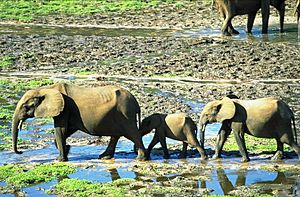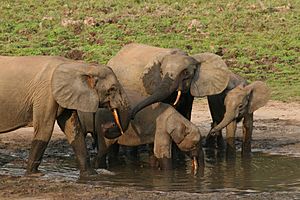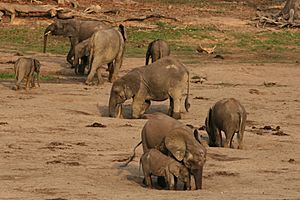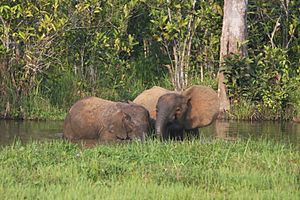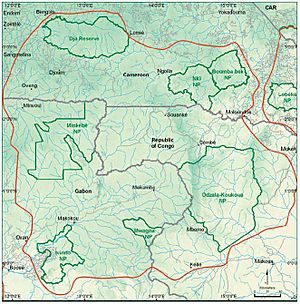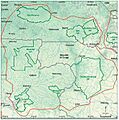African forest elephant facts for kids
Quick facts for kids African forest elephantTemporal range: Pleistocene - Recent
|
|
|---|---|
 |
|
| African forest elephants in Nouabalé-Ndoki National Park | |
| Conservation status | |
| Scientific classification | |
| Genus: |
Loxodonta
|
| Species: |
cyclotis
|
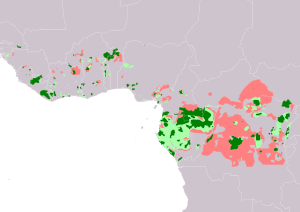 |
|
| Range of the African forest elephant Resident Possibly Extant (resident) Possibly extinct | |
The African forest elephant (Loxodonta cyclotis) is one of two types of African elephants. It lives in the wet forests of West Africa and the Congo Basin. This elephant is the smallest of the three living elephant species. It grows to about 2.4 m (7 ft 10 in) tall at the shoulder.
Both male and female forest elephants have straight tusks that point downwards. Their tusks start growing when they are 1 to 3 years old. These elephants live in family groups of up to 20 members. They eat leaves, seeds, fruit, and tree bark. Because of this, they are called the 'megagardener of the forest'. They play a big part in keeping the Guinean Forests of West Africa and the Congolese rainforests healthy.
Scientists first described this species in 1900. During the 1900s, too much hunting caused their numbers to drop a lot. By 2013, there were fewer than 30,000 left. Today, they are in danger because their homes are disappearing or breaking apart. They are also threatened by poaching, which is illegal hunting. Since 2021, the African forest elephant has been listed as Critically Endangered by the IUCN Red List. This means they are at a very high risk of becoming extinct.
African forest elephants make up about one-third of all elephants in Africa. However, they are hard to study because they live in very thick forests.
Contents
What Makes Them Special?
Male African forest elephants can be 2.4–3.0 m (7 ft 10 in – 9 ft 10 in) tall at the shoulder. Females are a bit smaller, usually 1.8–2.4 m (5 ft 11 in – 7 ft 10 in) tall. Males weigh between 4,000–7,000 kg (8,800–15,400 lb), while females weigh 2,000–4,000 kg (4,400–8,800 lb). Their footprints can be from 12.5 to 35.3 cm (4.9 to 13.9 in) big.
These elephants have grey skin. It can look yellow or reddish after they roll around in mud. They have some coarse black hair, especially on their tail. Their tail can be short or long enough to almost touch the ground. They have five toenails on their front feet and four on their back feet. Their back is mostly straight. Their ears are oval-shaped with small tips. The tip of their trunk has two finger-like parts.
The tusks of African forest elephants are straight and point down. Both males and females have them. These tusks are pink and are thinner and harder than those of the African bush elephant. Male tusks grow throughout their lives. Female tusks stop growing when they are old enough to have babies. Elephants use their tusks to push through thick plants in the forest. Tusks can grow to about 1.5 m (4 ft 11 in) long and weigh 23 to 45 kg (51 to 99 lb).
Where Do They Live?
African forest elephants live in large rainforests in Central Africa. These areas stretch from Cameroon to the Democratic Republic of the Congo. The biggest healthy population is in Gabon, where 90% of the country has good elephant habitat.
Sadly, the number of forest elephants in Central Africa dropped by about 86% in 31 years leading up to 2021. This was due to poaching and losing their homes. Countries like Cameroon, Congo, and the Central African Republic have also faced a lot of conflict. However, a 2021 survey in Gabon found about 95,000 forest elephants. Before this, the number was thought to be much lower, around 50,000 to 60,000.
They also live in the green forests of Ivory Coast and Ghana in West Africa.
How They Live and Interact
African forest elephants live in family groups. Groups seen in Gabon's Lopé National Park had between three and eight elephants. In the Dzanga-Sangha Complex of Protected Areas, groups of up to 20 elephants were seen. These groups included adult females, their daughters, and younger sons. Family members help each other care for the babies. This is called allomothering.
When young male elephants become adults, they leave their family group. They might form small groups with other males for a few days, but usually they stay alone. Adult males only join family groups during the mating season. Family groups travel about 7.8 km (4.8 mi) each day. Their home area can be as large as 2,000 km2 (770 sq mi).
They use a complex network of paths that go through fruit tree areas. These paths connect forest clearings with places where they can get important minerals. Humans and other animals also use these same paths.
In Odzala-Kokoua National Park, elephant groups often met at forest clearings. This shows they have a "fission–fusion society." This means groups can split up and come back together. They stayed longer when other groups were there. Smaller groups joined larger ones, and males joined family units.
What Do They Eat?
The African forest elephant is an herbivore, meaning it eats only plants. Elephants in Lopé National Park mostly ate tree bark and leaves. They also ate at least 72 different kinds of fruit.
To get enough minerals, they gather at waterholes and mineral licks that are rich in minerals.
Scientists have studied elephant dung piles. These piles contained seeds and fruit remains from many different plants. This shows how many different things they eat. In one study, a single dung pile had up to 1102 large seeds. It is thought that African forest elephants spread seeds from at least 73 tree species every day. They carry about one-third of these large seeds for more than 5 km (3.1 mi).
Seeds that pass through an elephant's gut grow faster. The African forest elephant is one of the best seed spreaders in tropical areas. It is called the "megagardener of the forest" because it helps keep many different plants alive. In one area, 14 out of 18 large tree species need African forest elephants to spread their seeds. These trees cannot survive without elephants.
African forest elephants provide important ecological services. They help keep the Central African forests healthy and diverse.
How Do They Talk?
We don't know much about how African forest elephants communicate. For these animals, hearing and smell are their most important senses. Their eyesight is not very good. They can feel and hear vibrations through the ground from far away. They can also find food using their strong sense of smell. Elephants can see well in both dim light and daylight. This is because their eyes adjust quickly to light changes.
An elephant's feet are very sensitive. They can feel vibrations through the ground, like thunder or other elephant calls, from up to 10 miles away.
How They Have Babies
Female elephants can start having babies when they are 8 to 12 years old. On average, they have their first baby at age 23. After that, they usually give birth every 5 to 6 years.
Baby elephants weigh about 105 kg (232 lb) when they are born. They can stand up and move around almost right away. The baby drinks milk using its mouth, holding its trunk over its head. Their tusks don't appear until they are about 16 months old. Baby elephants drink milk until they are around 4 or 5 years old.
Forest elephants usually live for about 60 to 70 years. Between the ages of 15 and 25, male elephants go through a hormonal state called "musth". During this time, they become more aggressive. A fluid comes out of a gland between their ear and eye. When in musth, males walk with their heads held high and tusks pointed inward. They might rub their heads on trees to spread their scent. They may also flap their ears and make a deep rumbling sound to spread their smell to other elephants. Males only return to the family group to mate or to socialize. They do not help raise their babies. Instead, they act like fathers to younger males, showing them how to be dominant.
Females can get pregnant multiple times a year. This is why they don't seem to have a specific breeding season.
What Dangers Do They Face?
People cut down forests to make space for farms, crops, and buildings. This means both types of African elephants are losing their homes. Their habitats are also becoming broken into smaller pieces. Poaching, which is illegally hunting elephants for their ivory tusks and for bushmeat, is a big problem in Central Africa. Because of a large increase in poaching, the African forest elephant was declared Critically Endangered in 2021. This happened after it was found that their population had dropped by more than 80% over three generations.
When their homes are broken into small pieces, some elephants get stuck in tiny forest areas. These areas might not have enough food for them. In 2014, a group called the International Fund for Animal Welfare helped move four elephants in Ivory Coast. They moved them from a small area to a larger protected park.
How Are They Protected?
In 1986, a project called the African Elephant Database started. Its goal was to keep track of how many African elephants there were.
Both types of African elephants have been listed under CITES Appendix I since 1989. CITES is an agreement that helps protect endangered animals. This listing means that countries that signed the agreement cannot trade wild African elephants or their parts across borders. Some populations in Botswana, Namibia, Zimbabwe, and South Africa were later moved to CITES Appendix II. Hunting elephants is against the law in the Central African Republic, Democratic Republic of Congo, Gabon, Côte d'Ivoire, and Senegal.
Images for kids
See also
 In Spanish: Elefante africano de bosque para niños
In Spanish: Elefante africano de bosque para niños




